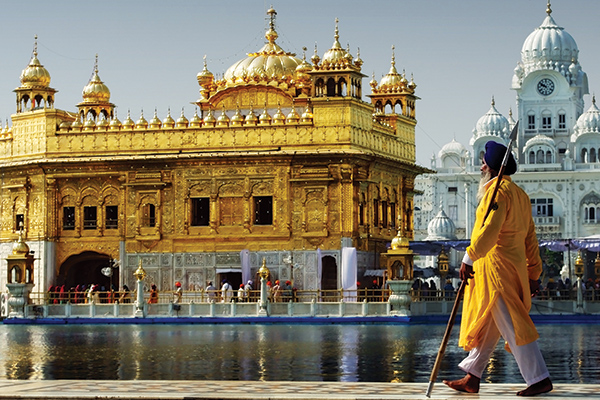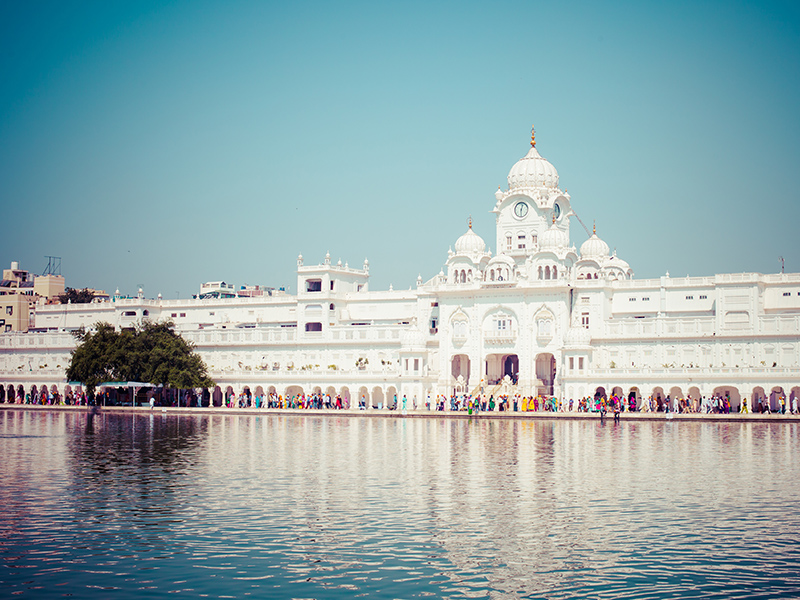Welcome To Amritsar – India’s Golden Jewel
India’s prize jewel, the Golden Temple is located in the city of Amritsar which is in the northwestern region of India. The incredible country of India is divided into states and Amritsar is in the Punjab state of India. Aside from being a major commercial and trade centre of India, Amritsar is the most important city in the Punjab region because it is the centre of Sikhism. The most prominent place of worship for the Sikhs is the iconic Golden Temple, or Hamandir Sahib as it is commonly known. Indeed, the Golden Temple is one of the most revered and visited places in the world as people flock to the site to see the gleaming gold temple as well as the other historic buildings around it. The Golden Temple is a sacred place of beauty and worship, however, nearby this iconic Indian landmark is the hauntingly sad history of the tragic events that eventually catapulted the rise of the Indian people against British Rule. Amritsar is a magical city of culture, beauty, and the historic Golden Temple. Many of Explore India’s award-winning tours include tours of the unforgettable city of Amritsar.
Where Does The Name Amritsar Come From?
In 1577 Guru Ram Das, 4th Guru of the Sikhs, founded Amritsar on a site granted to him by the Mughal emperor Akbar. Ram Das ordered the excavation of the sacred pool which was referred to as Amrita Saras. Pilgrims from all over the world gather around the giant pool of water surrounding the Golden Temple as the waters are considered to be the ‘nectar of immortality’. The name Amritsar is comprised of the two words Amrit (nectar of immortality) and Sarovar (pond).
The fifth Guru of the Sikhs, Arjan, built the temple in the middle of the pond and, over the years, the upper part of the temple was decorated in glimmering gold sheets, hence the name Golden Temple. Amritsar became the place in which the Sikh people worshipped and the Golden Temple, and surrounding buildings and waters, represented the symbolic beginnings of Sikh power, that is until it was annexed to British Rule.

The Golden Temple – Hamandir Sahib (Abode of God)
Is the gold on the Golden Temple real? Yes, the building was
not originally built with pure gold, but during the reign of Maharaja Rangit Singh (1801-1839), he had pure 24 carat gold gilded onto the Golden Temple. The Golden Temple is seen as a place of worship for anyone and the four entrances to the temple are symbolic of openness and acceptance and that people are welcome from every corner of the world. The Golden Temple is one of the holiest places on earth due to its inclusiveness of all, regardless of race or religion.
Sikhs within Amritsar and worshippers from around the world come primarily for the opportunity to worship at the Golden Temple. There are also other significant buildings near the temple that are important spaces for the Sikh faith.
Akal Takht is the chief central authority for Sikhism and houses the offices of the Shiromani Akali Dal or the Supreme Akali Party. This party is the main political party for Sikhs in the Punjab region. This building was built in 1605 and it faces the Darshini Deori which leads to the Golden Temple.
Teja Singh Sumundri Hall or Clock Tower is where the Supreme Committee of Temple Management assumes responsibility for overseeing the main Sikh gurdwaras or places of worship.

The Dining Hall is located behind the two red brick towers and is a place of monumental significance because thousands of people are lovingly fed there everyday. Regardless of one’s race or religion, the Sikh faith believes that everyone has the right to come into their sacred spaces to receive a nourishing meal at absolutely no cost to them at all.
Since the time of Guru Nanak, free hot meals, otherwise known at Langar, are served in every Sikh Gurudwara (place of worship) anywhere in the world. It is an amazingly beautiful experience to be welcomed into the dining halls of these places of worship and see the volunteers preparing huge amounts of vegetarian cuisine to be served to anyone who wishes to be served. A massive operation at any of the gurudwaras to say the least, however, the service at the Golden Temple is on such a large scale that it is truly astounding.
Every single day of the year between 50,000 and 75,000 hot, vegetarian meals are prepared and served to the people who come. During Diwali, or, Festival of Lights, that number increases to a staggering 125,000 – 150,000 meals per day. All of the produce, spices, and other ingredients are donated and all of the people preparing, serving, and cleaning up afterwards are all volunteers. A truly humbling experience to not only see the massive operation but if you can actually partake in their offerings it will leave you a changed person forever.
Jallianwallah Bagh
Of course, any article about Amritsar would not be complete if we did not mention the incredibly sad history of Jallianwallah Bagh. Located just a short distance from the Golden Temple, Jallianwallah Bagh is a large park where people have come together to gather for centuries. It is also where tragic events sparked Gandhi’s Salt March years later.
On April 13, 1919 Brigadier General Reginal Dyer ordered government troops to open fire on a group of unarmed Indian protesters who were gathered in the Jallianwallah Park square. As the crowd started to scream and tried to flee the square, they realized that the only doorway out of the square had been blocked and there was nowhere to run. The murders of these innocent people lasted several minutes killing 379 people and seriously wounding many, many more. It took some time, but in protest of British Rule and in honour of the massacre at Jallianwallah, Gandhi organized the Salt March in 1930. Through the months of March and April of 1930, the Indian people broke the law by marching in a peaceful protest against British Rule. Over 60,000 people were arrested during this peaceful march because it was viewed as an act of civil disobedience. Mahatma Gandhi was also arrested, however, this movement led to the eventual removal of British Rule in India and India’s independence was granted in 1947. Sadly, shortly after India gained its independence, Gandhi was gunned down on the grounds of his home in New Delhi. The assassin, Nathuram Godse, had the view that Gandhi had been too accommodating to the Muslim population in India during the Partition of India several months before the killing.
Most Explore India tours includes a trip to Birla House, Gandhi’s place of residence the last days of his life and is also the place he was murdered by Godse while he was giving a speech in his garden.
The City Of Amritsar
Aside from visiting the Golden Temple and the other historical and beautiful grounds and buildings near there, one can also take in some shopping at the many beautiful bazaars in Amritsar. Known for its textiles, silks, and other adornments, there is plenty of quality items to purchase while in Amritsar. Lahori Gate is a commercial centre in Amritsar with lots of shops, restaurants, and is especially known for its pashmina shawls.
The Wagah-Attari Border Ceremony and What To Expect There
A trip to Amritsar is not complete until you attend the historical and elaborate Wagah-Attari Border Ceremony. On an Explore India tour to Amritsar you will be escorted to the Wagah-Attari border which, at one time, was the only road that led to Pakistan from India. Every evening there is an elaborate ceremony where hundreds of people gather to see the showmanship and rivalry of the Indian and Pakistani border guards. A parade like atmosphere takes place with onlookers seated in the stands watching the colourful ceremony. It is a positive and somewhat uplifting ceremony where you witness the common people of these two countries simply enjoying in some comradery. As the sun sets the large gates dividing the two countries opens, the flags are lowered, the guards shake hands and it’s all done in an incredibly coordinated and almost dance like ritual. Explore India is proud to include this amazing ceremony in all its tours of Amritsar and is delighted to be able to offer this feature to all Explore India guests.
Amritsar and the Golden Temple is the most visited site in India and, indeed, the most visited place in the world. The majesty of the incredibly beautiful Golden Temple as well as the sacred waters and surrounding buildings is an experience you will remember for the rest of your life.
Explore India Journeys Inc. showcases the incredible city of Amritsar and visits to the Golden Temple on some of the award-winning tours we offer. Also, you can add a visit to Amritsar and the Golden Temple as an extension to any tour you choose with Explore India. Call a Travel Specialist at Explore India now to find out more – 1-800-515-3808.
Explore India and feel the magic that will change your life
